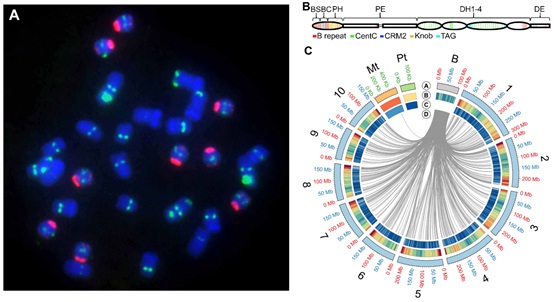
Researchers from China, Czech Republic, and USA Report Reference Genome for Maize B Chromosome
June 2, 2021| |
Three research groups from the University of Missouri, the Institute of Experimental Botany of the Czech Academy of Sciences, and the Institute of Genetics and Developmental Biology of the Chinese Academy of Sciences have recently reported a reference sequence for the supernumerary B chromosome in maize.
Supernumerary B chromosomes are present in thousands of plant and animal genomes despite being nonessential. They are maintained in populations by mechanisms of "drive" that make them inherited at higher than typical Mendelian rates. However, their key properties such as their origin, evolution, and the molecular mechanism for their accumulation in maize have remained unclear even though such chromosomes have been a potent tool for studying maize genetics.
The researchers discovered the rich availability of deletion derivatives ensured strong scaffolding and vetting of assembly. In addition, 758 protein-coding genes were identified from the 125.9-Mb of chromosome sequence, of which at least 88 are expressed. They also discovered that the current gene content is a result of continuous transfer from the A chromosomal complement over an extended evolutionary period. Annotation results show that transposable elements in the B chromosome are shared with the standard A chromosome set. However, the failure of multiple lines of evidence to reveal a syntenic region in the B chromosome with any A chromosome indicates that this chromosome has been present in the evolutionary lineage for millions of years since any such synteny has disintegrated.
For more details, read the news article in the Chinese Academy of Sciences Newsroom.
| |
You might also like:
- GM Maize for Human Consumption Show Higher Yield Gains than Maize for Livestock in South Africa
- Biotech Tools to Boost Essential Amino Acids in Maize
- Scientists Improve Antioxidant Content of Maize
Biotech Updates is a weekly newsletter of ISAAA, a not-for-profit organization. It is distributed for free to over 22,000 subscribers worldwide to inform them about the key developments in biosciences, especially in biotechnology. Your support will help us in our mission to feed the world with knowledge. You can help by donating as little as $10.
-
See more articles:
-
News from Around the World
- International Research Team Identifies Pathway for Accelerated Plant Flowering in Low-Nitrogen Soils
- ISAAA Webinar: What is Gene Drive?
- Over 2,000 Nigerian Farmers Reaping the Benefits of Biotechnology
- Canada Approves HB4 Drought Tolerant Soybeans
- Study Finds Key Protein in Plant's Response to Nitrogen Deficiency
- GM Maize Adoption Increases by 31% Every Year in the Philippines, Benefiting More Resource-poor Farmers
- Scientists Call for International Investment to Tackle Major Wheat Losses
- Scientists Provides New Tool in Breeding More Climate-Resilient Cole Crops
-
Research Highlights
- Researchers from China, Czech Republic, and USA Report Reference Genome for Maize B Chromosome
- GE Potato Plant Responds to Stress by Glowing
-
Plant
- Orange Poinsettias Developed Using CRISPR-Cas9
- International Trade in Crops with New Breeding Technologies: The Australian Perspective
-
Read the latest: - Biotech Updates (December 17, 2025)
- Gene Editing Supplement (December 17, 2025)
- Gene Drive Supplement (February 22, 2023)
-
Subscribe to BU: - Share
- Tweet

